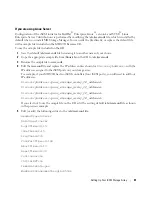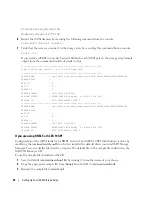
Setting Up Your iSCSI Storage Array
55
If you are using Windows Server 2008 Core Version
1
Set the iSCSI initiator services to start automatically (if not already set):
sc \\<server_name> config msiscsi start= auto
2
Start the iSCSI service (if necessary):
sc start msiscsi
3
Log on to the target:
iscsicli PersistentLoginTarget <
Target_Name
> <
Report_To_PNP
>
<
Target_Portal_Address
> <
TCP_Port_Number_Of_Target_Portal
>
* * *
<
Login_Flags
>
* * * * *
<
Username
> <
Password
> <
Authtype
>
*
<
Mapping_Count
>
where
<
Target_Name
>
is the target name as displayed in the target list. Use the
iscsicli
ListTargets
command to display the target list.
<
Report_To_PNP
>
is
T
, which exposes the LUN to the operating system as a storage device.
<
Target_Portal_Address
>
is the IP address of the iSCSI port on the controller being logged in
to.
<
TCP_Port_Number_Of_Target_Portal
>
is
3260
.
<
Login_Flags
>
is
0x2
to enable multipathing for the target on the initiator. This value allows more
than one session to be logged in to a target at one time.
<
Username
>
is the initiator name.
<
Password
>
is the target CHAP secret.
<
Authtype
>
is either
0
for no authentication,
1
for Target CHAP, or
2
for Mutual CHAP.
NOTE:
<
Username
>, <
Password
> and <
Authtype
> are optional parameters. They can be replaced with an
asterisk (*) if CHAP is not used.
<
Mapping_Count
>
is
0
, indicating that no mappings are specified and no further parameters are
required.
* * *
An asterisk (*) represents the default value of a parameter.
For example, your logon command might look like this:
iscsicli PersistentLoginTarget
iqn.1984-05.com.dell:powervault.6001372000ffe333000000004672edf2
3260 T 192.168.130.101 * * * 0x2 * * * * * * * * * 0
Summary of Contents for PowerVault MD3000i
Page 6: ...6 Contents ...














































